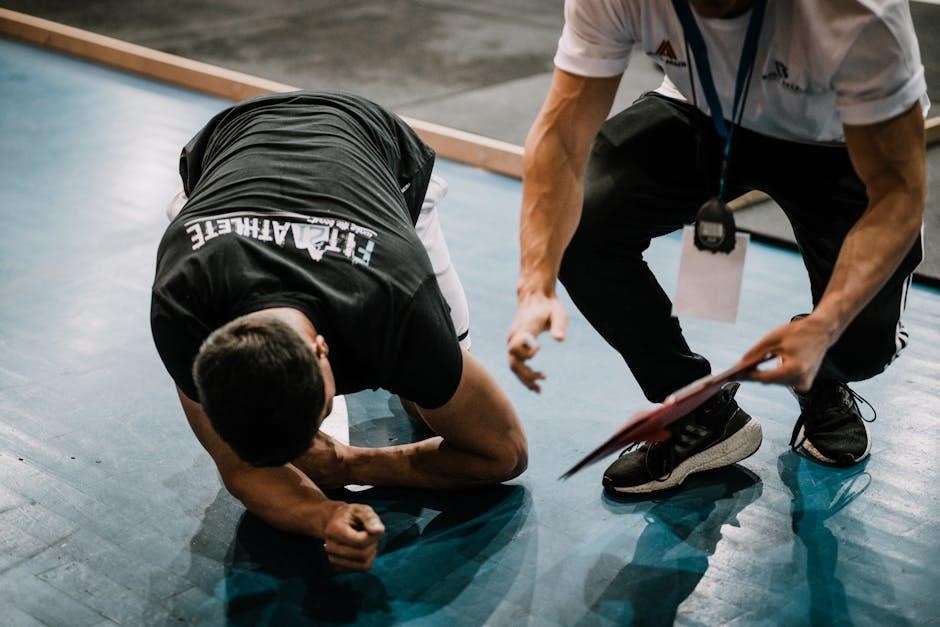Overview of the Training Plan
An 800m training program pdf typically includes a detailed outline of the training structure, with specific goals and objectives for each phase, and a comprehensive plan for progressing athletes through different levels of training. The plan should be tailored to the individual athlete’s needs and goals, taking into account their current fitness level, training experience, and competitive schedule. A well-structured training plan should also include a mix of different types of training, such as endurance, speed, and strength work, to ensure that the athlete develops a balanced range of skills and abilities. Additionally, the plan should be flexible enough to allow for adjustments to be made as needed, in response to changes in the athlete’s circumstances or progress. By following a structured training plan, athletes can optimize their performance, reduce their risk of injury, and achieve their goals in the 800m event. Effective planning is essential.

Components of an 800m Training Program
Key components include proper warm-ups, cool-downs, and nutrition advice always effectively.
Speed Work and Interval Training
Speed work and interval training are crucial components of an 800m training program, allowing athletes to develop speed, endurance, and mental toughness.
These types of training involve short bursts of high-intensity running, followed by periods of rest or active recovery.
Interval training can be tailored to an athlete’s specific needs and goals, with varying distances, intensities, and recovery periods.
For example, a common interval workout for 800m runners might involve 4-6 repetitions of 200m or 400m at a fast pace, with 200m or 400m active recovery in between.
This type of training helps athletes build lactate tolerance, increase their anaerobic capacity, and develop the ability to maintain a fast pace over a prolonged period.
By incorporating speed work and interval training into their program, athletes can improve their overall performance and achieve their goals in the 800m event.
Properly structured interval workouts can also help reduce the risk of injury and prevent overtraining.
Athletes should work with a qualified coach to develop a personalized training plan that includes speed work and interval training.

Importance of Core Strengthening Exercises
Core exercises provide stability and support for the spine and pelvis, reducing injury risk always effectively.
Reducing the Risk of Lower Back Pain and Injury
Reducing the risk of lower back pain and injury is crucial for 800m runners, as it can significantly impact their performance and overall health. A well-structured training program should include exercises that strengthen the core muscles, providing stability and support for the spine and pelvis. This can be achieved through a variety of exercises, such as planks, bridges, and pelvic tilts. By incorporating these exercises into their training routine, runners can reduce their risk of injury and improve their overall performance. Additionally, proper running form and technique can also help to reduce the risk of lower back pain and injury. Runners should focus on maintaining a upright posture, engaging their core muscles, and avoiding overstriding. By taking a proactive approach to reducing the risk of injury, runners can stay healthy and compete at their best. Effective training is essential for success.
Recovery Strategies for 800m Runners
Recovery strategies for 800m runners include rest, nutrition, and hydration to repair muscles and replenish energy always effectively.
Allowing the Body to Adapt and Improve
Allowing the body to adapt and improve is a critical aspect of an 800m training program, as it enables the body to recover from the stresses of training and become stronger.
The body’s adaptation to training is a complex process that involves various physiological changes, including increases in muscle strength, endurance, and cardiovascular function.
A well-structured training program should include periods of recovery and adaptation, allowing the body to repair and rebuild itself after intense training.
This can be achieved through techniques such as active recovery, which involves low-intensity exercise, and passive recovery, which involves rest and relaxation.
By incorporating recovery and adaptation into an 800m training program, athletes can optimize their performance, reduce the risk of injury, and achieve their goals.
Proper recovery and adaptation techniques can help athletes to improve their overall performance and achieve success in the 800m event.
The adaptation process is essential for athletes to reach their full potential and achieve optimal results.
Effective recovery strategies can help athletes to recover faster and improve their performance over time.
A well-planned training program can help athletes to adapt to the demands of training and improve their overall performance.
The body’s ability to adapt to training is a key factor in determining an athlete’s success in the 800m event.
Proper training and recovery techniques can help athletes to achieve their goals and reach their full potential.
The recovery process is an essential part of an 800m training program, and it should be given equal importance as the training itself.
A well-structured training program can help athletes to adapt to the demands of training and improve their overall performance, leading to success in the 800m event.
The importance of recovery and adaptation cannot be overstated, as it is a critical aspect of an 800m training program.
By incorporating proper recovery and adaptation techniques into a training program, athletes can optimize their performance and achieve their goals.
The adaptation process is a critical aspect of an 800m training program, and it should be carefully planned and executed to ensure optimal results.
Proper training and recovery techniques can help athletes to achieve their goals and reach their full potential in the 800m event.
The recovery process is essential for athletes to recover from the stresses of training and become stronger, and it should be given equal importance as the training itself.
A well-planned training program can help athletes to adapt to the demands of training and improve their overall performance, leading to success in the 800m event, and the importance of recovery and adaptation cannot be overstated.

Periodization of an 800m Training Program
A well-structured 800m training program pdf includes macrocycle and mesocycle planning with specific developmental goals always implemented effectively within a season-long training plan framework successfully every time.
General Preparation, Endurance, and Speed Development
The general preparation phase of an 800m training program pdf focuses on building a strong foundation of endurance and speed, with a emphasis on progressive overload and variation in training stimuli. This phase typically lasts for several weeks and includes a mix of aerobic and anaerobic training, as well as strength and conditioning exercises to improve overall athleticism. The endurance component involves building a strong aerobic base through longer runs and tempo workouts, while the speed development component involves shorter, more intense intervals to improve neuromuscular power and speed. A well-structured 800m training program pdf will also include a periodization plan that outlines the specific training goals and objectives for each phase, ensuring a gradual and progressive increase in intensity and difficulty. This approach helps to reduce the risk of injury and improve overall performance.

Sample 800m Training Plans
Sample plans include various training phases and periods, with specific workouts and exercises, to help athletes achieve their goals, using a structured and progressive approach always effectively.
Training Plans for Different Seasons and Goals
Training plans for different seasons and goals are essential for 800m runners, as they provide a structured approach to achieving specific objectives. The plans are typically designed to cater to various seasons, such as the indoor and outdoor track seasons, and goals, including improving endurance, speed, and overall performance. By having a well-structured plan, athletes can focus on specific aspects of their training, such as building endurance in the fall, increasing speed in the indoor season, and simulating race strategies in the outdoor season. This approach enables athletes to peak at the right time and perform optimally during competitions. Additionally, having plans for different seasons and goals allows athletes to adapt to changing circumstances and make adjustments as needed, ensuring they stay on track and achieve their desired outcomes, which is critical for success in the 800m event, and requires careful planning and execution always.


